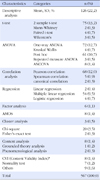Abstract
Purpose
The purpose of this study was to identify the major trends in research studies in the Journal of Korean Academy of Nursing Administration from 2010 to 2012.
Methods
A review using analysis criteria developed by researchers was done of 132 studies published between 2010 and 2012. Research design, participants, research domain, and keywords were analyzed from the Journal of Korean Nursing Administration.
Results
Job satisfaction, stress, organizational commitment, safety, turnover, nursing education, and performance were found to be major keywords. Of the research in the Journal, quantitative methods were used in 93.2% of studies. The major setting and participants were hospitals (58.2%) and nurses (65.5%) respectively. Prevalent analysis methods used were t-test, ANOVA, correlation, regression, chi-square, AMOS, and factor analysis. Major domains in the articles were: controlling, directing, staffing, nursing management education, and professionalism & legal principles.
Conclusion
Through this study, the research trends in nursing administration were identified, but there is a need to include more of the following topics in future research: new concepts in nursing policy, enhanced deliberations of IRB, rationalization of the effects in sample size calculations, theoretical development of planning and organizing, and development of interventions for management support of the nursing management process.
References
1. Bang KS, Lee SO, Park YI, Jun MH, Kim HS, Son HM, et al. Analysis of published papers and their keywords in the Journal of Korean Academic Society of Nursing Education 2007. J Korean Acad Soc Nurs Educ. 2008; 14:244–251. http://dx.doi.org/10.5977/jkasne.2008.14.2.244.
2. Choe MA, Jeong JS, Lim KC, Kim JH, Kim KS, Kwon JS, et al. Research trend of studies published in Journal of Korean Clinical Nursing Research 1995-2008. J Korean Clin Nurs Res. 2010; 16:95–105.
3. Choi KS, Song MS, Hwang AR, Kim KH, Chung MS, Shin SR, et al. The trend of nursing research in the Journal of the Korean Academy of Nursing. J Korean Acad Nurs. 2000; 30:1207–1218.
4. Chang SO. Analysis of research papers published in the Journal of Korean Academy of Nursing by the classification of knowing in nursing. J Korean Acad Nurs. 2005; 35:206–212.
5. Jeong GH, Ahn YM, Cho DS. Coincidence analysis of key words of the Journal of Korean Academy of Nursing with MeSH. J Korean Acad Nurs. 2005; 35:1420–1425.
6. Kang HC. Analysis of statistical method applied in the Journal of Korean Academy of Nursing. J Korean Acad Nurs. 2002; 32:929–935.
7. Kim JK, Jung MS, Jang KS, Kim JY, Lee HJ, Kim EK, et al. Analysis of the Journal of Korean Academy of Nursing Administration for 3 years (2007-2009). J Korean Acad Nurs Adm. 2010; 16:517–526. http://dx.doi.org/10.11111/jkana.2010.16.4.517.
8. Kim K, Chang SO, Kang HS, Kim KS, Kim JI, Kim H, et al. Trends in research studies published in Journal of Korean Academy Fundamentals of Nursing: 2009-2011. J Korean Acad Fundam Nurs. 2012; 19:383–391. http://dx.doi.org/10.7739/jkafn.2012.19.3.383.
9. Kim SJ, Kim KB, Yi MS, Lee KJ, Ahn YH, Kim HS, et al. The trends of nursing research in the journals of seven branches of the Korean Academy of Nursing. J Korean Acad Nurs. 2002; 32:114–130.
10. Koh MS, Ha NS. Review of the Journal of Korean Nursing Administration Academic Society and its research trends. J Korean Acad Nurs Adm. 2001; 7:561–569.
11. Lee EO, Lee EJ, Lee EH, Chun KZ, Kim JH, Park CS, et al. Analysis of studies of anxiety and stress conducted in Korea from 1970 to 1990. J Korean Acad Nurs. 1992; 22:271–296.
12. Lee MH, Sohn JN, Won CS, Chung MS, Hyun MS, Han KS, et al. Trend of psychiatric nursing research by analysis of the published paper in Journal of Korean Academy of Psychiatric and Mental Health Nursing: On papers from 1992 to 2006. J Korean Acad Psychiatr Ment Health Nurs. 2007; 16:295–307.
13. Marriner-Tomey A. Nursing management and leadership. 8th ed. Missouri: Elsevier;2009.
14. Seomun GA, Koh MS. Academic value and outcome of the Journal of Korean Academy of Nursing Administration. J Korean Acad Nurs Adm. 2007; 13:546–552.
15. Seomun GA, Koh MS, Kim IA. Classification of keywords of the papers from the Journal of Korean Academy of Nursing Administration(2002-2006). J Korean Acad Nurs Adm. 2007; 13:118–122.
16. Shin HS, Hyun MS, Ku MO, Cho MO, Kim SY, Jeong JS, et al. Analysis of research papers published in the Journal of the Korean Academy of Nursing-Focused on research trends, intervention studies, and level of evidence in the research. J Korean Acad Nurs. 2010; 40:139–149. http://dx.doi.org/10.4040/jkan.2010.40.1.139.
17. Suh YO, Park JS, Yang JH, Kim HW, Suk MH, Shin HS, et al. Analysis of research papers published in the Journal of Korean Academy of Nursing. J Korean Acad Nurs. 2007; 37:1013–1019.
18. Swansburg RC. Introductory management and leadership for clinical nurses: A text-workbook. Boston: Jones and Barlett Publishers;1993.




 PDF
PDF ePub
ePub Citation
Citation Print
Print







 XML Download
XML Download